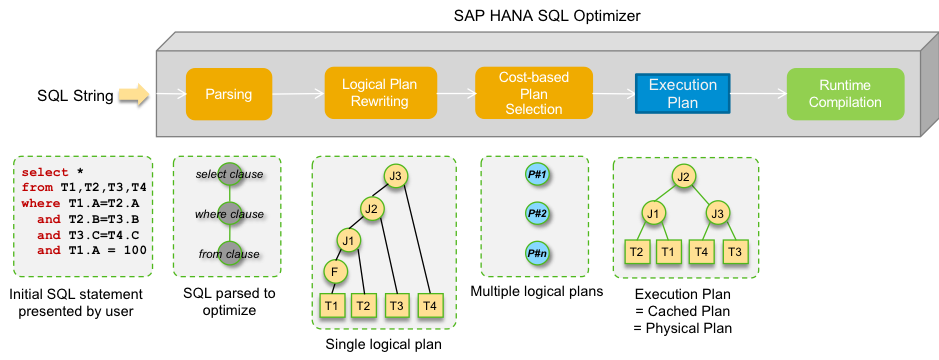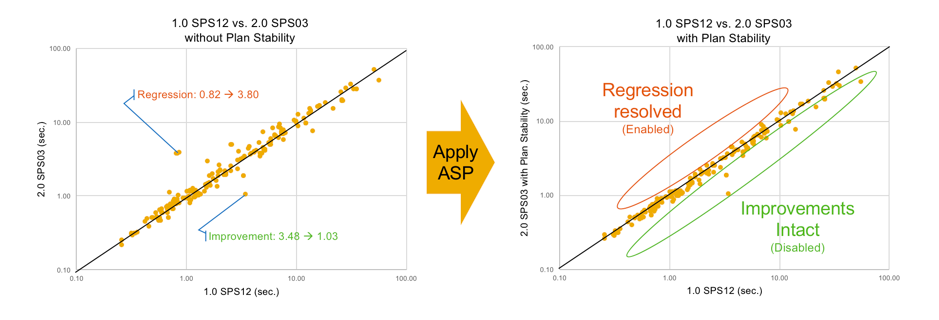
- SAP Community
- Products and Technology
- Technology
- Technology Blogs by SAP
- Protect from performance regression with SQL Plan ...
Technology Blogs by SAP
Learn how to extend and personalize SAP applications. Follow the SAP technology blog for insights into SAP BTP, ABAP, SAP Analytics Cloud, SAP HANA, and more.
Turn on suggestions
Auto-suggest helps you quickly narrow down your search results by suggesting possible matches as you type.
Showing results for
Product and Topic Expert
Options
- Subscribe to RSS Feed
- Mark as New
- Mark as Read
- Bookmark
- Subscribe
- Printer Friendly Page
- Report Inappropriate Content
07-03-2018
7:25 AM
As SAP HANA Platform evolves with each new release, the SQL optimization team continuously enhances additional optimizations and support for added new features for each release. With the new improvements, the SQL Query Processor generates somewhat different plan from the previous versions and some performance regression may occur. SQL Plan Stability was introduced to avoid such possible performance regressions and controls the execution time to be within the expected boundaries.
To understand how this is achieved, let’s dive into how the SQL Query Processor works behind the scenes. When a new SQL statement is received from a client, it is evaluated by the SQL Optimizer with several steps that needs to be done to compile, pick and cache the best physical execution plan. The following diagram shows simplified steps without SQL Plan Stability.

With SQL Plan Stability, the physical execution plan related information is collected and stored as Abstract SQL Plan (ASP) to the persistent storage for future reference. This information can be used to skip the existing rewriting steps but still able to recreate the same execution plan based on the logical plan and physical properties stored in ASP.
Now let’s look into when the same SQL statement is received again. The statement is first check against the plan cache if it is already cached for faster execution. There will be times where the existing plan is invalidated and need to be recompiled. At this time, when SQL Plan Stability activated, it will check if an Abstract SQL Plan of the SQL statement already exists. Unlike the SQL Plan Cache, the Abstract SQL Plan is not evicted and kept in storage unless manually removed. If ASP already exists, the logical plan with physical properties are loaded back into the SQL Query Optimizer, validated and passed on to the execution plan generation step for final compilation.

We have tested upgrading from HANA 1.0 SPS12 to HANA 2.0 SPS03 with 202 statements captured as ASP with the execution times of each statements in the following test results.

If the conditions are the same, the execution time will be identical and lined up diagonally. Below the line shows improvements and above regression. First, the left side show results without Plan Stability where above and below. To improve the execution time for statements with regression, ASP is applied to enforce the existing execution plan is used. For improved statements, ASP is not applied to keep the execution time improvements. The right side show the results after ASP is activated improving statements with regression.
With the new SQL Plan Stability, two key benefits are obtained. First, the ASP stored will generate the same execution plan based on the existing logical plan and physical properties saved whenever possible. Thus, it will avoid any performance regressions and achieve plan stability. Second, the logical plan enumeration step is skipped reducing the total compilation time which can reduce preparation time for very complex queries.
SQL Plan Stability is a two-step process. First, “Capture” to store the ASP. Second, “Apply” to activate the ASP for execution plan creation. Please find the most updated information regarding restrictions from Note #2639193 – SAP HANA SQL Plan Stability.
To understand how this is achieved, let’s dive into how the SQL Query Processor works behind the scenes. When a new SQL statement is received from a client, it is evaluated by the SQL Optimizer with several steps that needs to be done to compile, pick and cache the best physical execution plan. The following diagram shows simplified steps without SQL Plan Stability.

With SQL Plan Stability, the physical execution plan related information is collected and stored as Abstract SQL Plan (ASP) to the persistent storage for future reference. This information can be used to skip the existing rewriting steps but still able to recreate the same execution plan based on the logical plan and physical properties stored in ASP.
Now let’s look into when the same SQL statement is received again. The statement is first check against the plan cache if it is already cached for faster execution. There will be times where the existing plan is invalidated and need to be recompiled. At this time, when SQL Plan Stability activated, it will check if an Abstract SQL Plan of the SQL statement already exists. Unlike the SQL Plan Cache, the Abstract SQL Plan is not evicted and kept in storage unless manually removed. If ASP already exists, the logical plan with physical properties are loaded back into the SQL Query Optimizer, validated and passed on to the execution plan generation step for final compilation.

We have tested upgrading from HANA 1.0 SPS12 to HANA 2.0 SPS03 with 202 statements captured as ASP with the execution times of each statements in the following test results.

If the conditions are the same, the execution time will be identical and lined up diagonally. Below the line shows improvements and above regression. First, the left side show results without Plan Stability where above and below. To improve the execution time for statements with regression, ASP is applied to enforce the existing execution plan is used. For improved statements, ASP is not applied to keep the execution time improvements. The right side show the results after ASP is activated improving statements with regression.
With the new SQL Plan Stability, two key benefits are obtained. First, the ASP stored will generate the same execution plan based on the existing logical plan and physical properties saved whenever possible. Thus, it will avoid any performance regressions and achieve plan stability. Second, the logical plan enumeration step is skipped reducing the total compilation time which can reduce preparation time for very complex queries.
SQL Plan Stability is a two-step process. First, “Capture” to store the ASP. Second, “Apply” to activate the ASP for execution plan creation. Please find the most updated information regarding restrictions from Note #2639193 – SAP HANA SQL Plan Stability.
- SAP Managed Tags:
- SQL,
- SAP HANA,
- SAP HANA, platform edition
You must be a registered user to add a comment. If you've already registered, sign in. Otherwise, register and sign in.
Labels in this area
-
ABAP CDS Views - CDC (Change Data Capture)
2 -
AI
1 -
Analyze Workload Data
1 -
BTP
1 -
Business and IT Integration
2 -
Business application stu
1 -
Business Technology Platform
1 -
Business Trends
1,661 -
Business Trends
86 -
CAP
1 -
cf
1 -
Cloud Foundry
1 -
Confluent
1 -
Customer COE Basics and Fundamentals
1 -
Customer COE Latest and Greatest
3 -
Customer Data Browser app
1 -
Data Analysis Tool
1 -
data migration
1 -
data transfer
1 -
Datasphere
2 -
Event Information
1,400 -
Event Information
64 -
Expert
1 -
Expert Insights
178 -
Expert Insights
270 -
General
1 -
Google cloud
1 -
Google Next'24
1 -
Kafka
1 -
Life at SAP
784 -
Life at SAP
11 -
Migrate your Data App
1 -
MTA
1 -
Network Performance Analysis
1 -
NodeJS
1 -
PDF
1 -
POC
1 -
Product Updates
4,578 -
Product Updates
323 -
Replication Flow
1 -
RisewithSAP
1 -
SAP BTP
1 -
SAP BTP Cloud Foundry
1 -
SAP Cloud ALM
1 -
SAP Cloud Application Programming Model
1 -
SAP Datasphere
2 -
SAP S4HANA Cloud
1 -
SAP S4HANA Migration Cockpit
1 -
Technology Updates
6,886 -
Technology Updates
395 -
Workload Fluctuations
1
Related Content
- Workload Analysis for HANA Platform Series - 3. Identify the Memory Consumption in Technology Blogs by SAP
- SAP Datasphere - Space, Data Integration, and Data Modeling Best Practices in Technology Blogs by SAP
- Workload Analysis for HANA Platform Series - 0. HANA Workload Analysis Overview in Technology Blogs by SAP
- Workload Analysis for HANA Platform Series - 2. Analyze the CPU, Threads and Numa Utilizations in Technology Blogs by SAP
- Boosting Benchmarking for Reliable Business AI in Technology Blogs by SAP
Top kudoed authors
| User | Count |
|---|---|
| 11 | |
| 10 | |
| 10 | |
| 9 | |
| 8 | |
| 7 | |
| 7 | |
| 7 | |
| 7 | |
| 6 |